Word 2013
Indents and Tabs
Introduction
Indenting text adds structure to your document by allowing you to separate information. Whether you'd like to move a single line or an entire paragraph, you can use the tab selector and the horizontal ruler to set tabs and indents.
Optional: Download our Lesson 11 Practice Document.
Indenting text
In many types of documents, you may wish to indent only the first line of each paragraph. This helps to visually separate paragraphs from one another. It's also possible to indent every line except for the first line, which is known as a hanging indent.
 First line indent
First line indent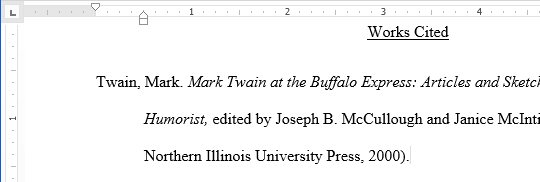 Hanging indent
Hanging indentTo indent using the Tab key:
A quick way to indent is to use the Tab key. This will create a first line indent of 1/2 inch.
- Place the insertion point at the very beginning of the paragraph you wish to indent.
 Placing the insertion point
Placing the insertion point - Press the Tab key. On the ruler, you should see the first-line indent marker move to the right by 1/2 inch.
- The first line of the paragraph will be indented.
 The indented paragraph
The indented paragraph
If you can't see the ruler, select the View tab and then click the check box  next to Ruler.
next to Ruler.
 Showing the Ruler
Showing the RulerIndent markers
In some cases, you may wish to have more control over indents. Word provides indent markers that allow you to indent paragraphs to the location you desire. The indent markers are located to the left of the horizontal ruler, and they provide several indenting options:
- First-line indent marker
 : Adjusts the first-line indent
: Adjusts the first-line indent - Hanging indent marker
 : Adjusts the hanging indent
: Adjusts the hanging indent - Left indent marker
 : Moves both the first line indent and hanging indent markers at the same time (this will indent all lines in a paragraph)
: Moves both the first line indent and hanging indent markers at the same time (this will indent all lines in a paragraph)
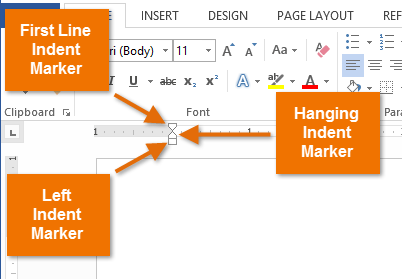 The three indent markers
The three indent markers
To indent using the indent markers:
- Place the insertion point anywhere in the paragraph you wish to indent, or select one or more paragraphs.
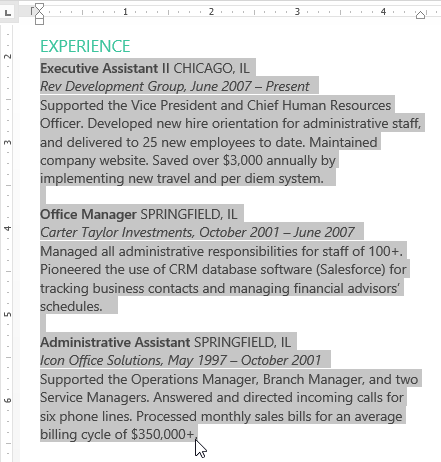 Selecting paragraphs to indent
Selecting paragraphs to indent - Click, hold, and drag the desired indent marker. In our example, we'll click, hold, and drag the left indent marker. A live preview of the indent will appear in the document.
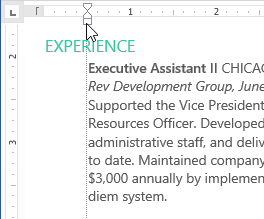 Moving a paragraph
Moving a paragraph - Release the mouse. The paragraphs will be indented.
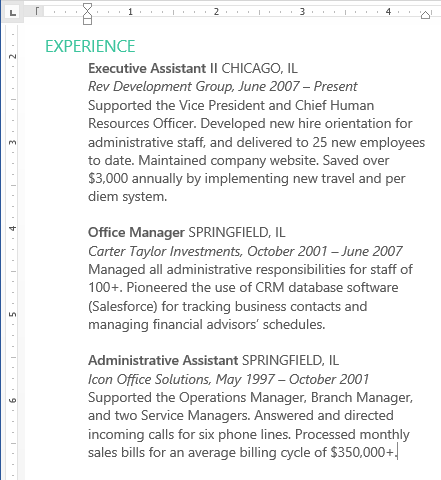 The indented paragraphs
The indented paragraphs
To indent using the Indent commands:
If you want to indent multiple lines of text or all lines of a paragraph, you can use the Indent commands.
- Select the text you wish to indent.
 Selecting text to indent
Selecting text to indent - On the Home tab, click the desired Indent command:
- Increase Indent: Increases the indent by increments of 1/2 inch. In our example, we'll increase the indent.
- Decrease Indent: Decreases the indent by increments of 1/2 inch.
 The Indent commands
The Indent commands
- The text will indent.
 The indented text
The indented text
To customize the indent amounts, select the Page Layout tab and enter the desired values in the boxes under Indent.
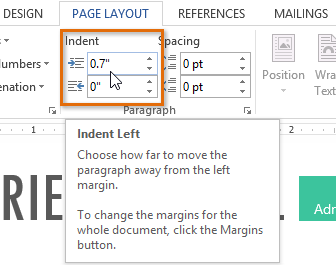 Customizing the indent amounts
Customizing the indent amountsTabs
Using Tabs gives you more control over the placement of text. By default, every time you press the Tab key, the insertion point will move 1/2 inch to the right. Adding tab stops to the ruler allows you to change the size of the tabs, and Word even allows you to apply more than one tab stop to a single line. For example, on a resume you could Left Align the beginning of a line and Right Align the end of the line by adding a Right Tab.
 Using two types of alignment on the same line
Using two types of alignment on the same linePressing the tab key can either add a tab or create a first-line indent, depending on where the insertion point is. Generally, if the insertion point is at the beginning of an existing paragraph, it will create a first-line indent; otherwise, it will create a tab.
The tab selector
The tab selector is located above the vertical ruler on the left. Hover the mouse over the tab selector to see the name of the active tab stop.
 The tab selector
The tab selectorTypes of tab stops include:
- Left Tab
 : Left-aligns the text at the tab stop
: Left-aligns the text at the tab stop - Center Tab
 : Centers the text around the tab stop
: Centers the text around the tab stop - Right Tab
 : Right-aligns the text at the tab stop
: Right-aligns the text at the tab stop - Decimal Tab
 : Aligns decimal numbers using the decimal point
: Aligns decimal numbers using the decimal point - Bar Tab
 : Draws a vertical line on the document
: Draws a vertical line on the document - First Line Indent
 : Inserts the indent marker on the ruler, and indents the first line of text in a paragraph
: Inserts the indent marker on the ruler, and indents the first line of text in a paragraph - Hanging Indent
 : Inserts the hanging indent marker, and indents all lines other than the first line
: Inserts the hanging indent marker, and indents all lines other than the first line
Although Bar Tab, First Line Indent, and Hanging Indent appear on the tab selector, they're not technically tabs.
To add tab stops:
- Select the paragraph or paragraphs you want to add tab stops to. If you don't select any paragraphs, the tab stops will apply to the current paragraph and any new paragraphs you type below it.
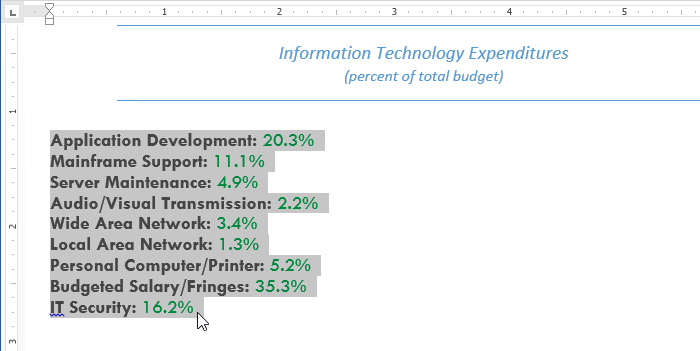 Selecting text to tab
Selecting text to tab - Click the tab selector until the tab stop you wish to use appears. In our example, we'll select the Decimal Tab.
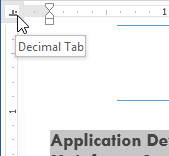 Selecting a tab stop
Selecting a tab stop - Click the location on the horizontal ruler where you want your text to appear (it helps to click on the bottom edge of the ruler). You can add as many tab stops as you want.
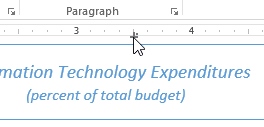 Adding a tab stop to the Ruler
Adding a tab stop to the Ruler - Place the insertion point in front of the text you wish to tab, then press the Tab key. The text will jump to the next tab stop.
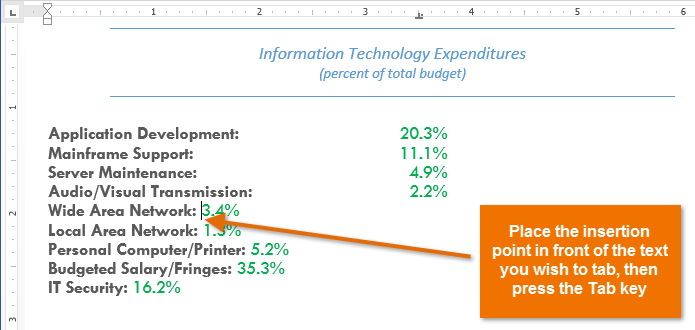 Moving text to the Tab stop
Moving text to the Tab stop
To remove a tab stop, click, hold, and drag it off of the ruler.
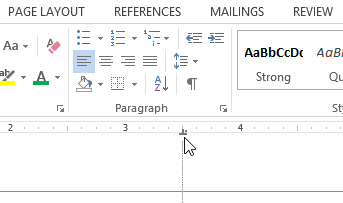 Removing a tab stop
Removing a tab stopWord can display hidden formatting symbols such as the space bar ( ), paragraph (
), paragraph ( ), and Tab key (
), and Tab key ( ) markings to help you see the formatting in your document. To show hidden formatting symbols, select the Home tab, then click the Show/Hide command.
) markings to help you see the formatting in your document. To show hidden formatting symbols, select the Home tab, then click the Show/Hide command.
 Displaying hidden formatting symbols
Displaying hidden formatting symbolsChallenge!
- Open an existing Word document. If you want, you can use our Lesson 11 Practice Document.
- Practice using the Tab key to indent some text. If you're using the example, try indenting the second and third paragraphs of the thank-you letter.
- Select a paragraph, and try creating a hanging indent.
- Select some text, and use the Increase and Decrease Indent commands to see how they change the text. If you're using our example, practice increasing and decreasing the indent of the text in the "Summary" section of the resume.
- Explore the tab selector and tab stops. If you're using our example, select the text in the "Experience" section of the resume and add a Left tab stop at 3 inches. Then align each of the cities to the tab stop.



